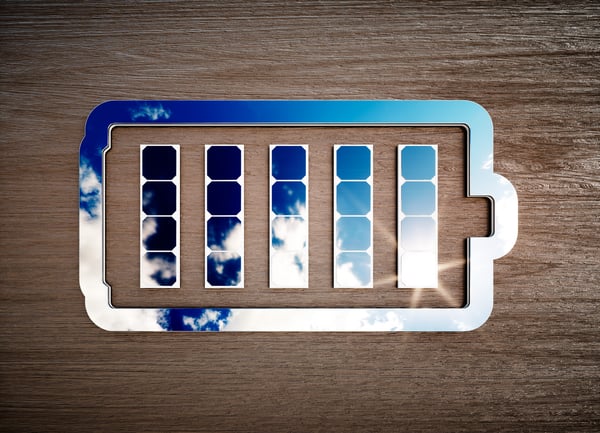Battery Energy Storage Systems (BESS) store energy during times of high production/low demand and then discharge it during times of low production/high demand. Like any energy source at a solar PV plant, BESS must be monitored and controlled. This is done by three systems:
- The Energy Management System (EMS) monitors grid demand and how the required energy can be transferred from the BESS. This is done through control logic. The EMS sends an input signal to either charge or discharge the battery based on the control logic requirement and the SOC of the battery system.
- The Battery Management System (BMS) monitors the battery's health, output, voltage, temperature, fire warning and state of charge (SOC). It also regulates the charging and discharging power based on the input signal.
- The Supervisory Control and Data Acquisition (SCADA) system communicates with and controls devices throughout the solar PV plant. It is the nerve center of the entire operation, and the means by which operators can monitor plant operations and send commands. It is also possible for the SCADA system to take on the role of the EMS.
For a refresher on how BMS and EMS work, see our article on BESS and grid support. Here, we will cover how BESS integrates with SCADA.
1. What battery devices directly communicate with the SCADA system?
The SCADA system typically communicates with the BMS directly to monitor battery readings. It may also be beneficial or required for the SCADA system to communicate with DC-DC converters, inverters, and auxiliary meters in order to properly control the BMS.
2. What information from the batteries is displayed on the HMI?
Key readings that are passed through from the batteries/stacks include SOC, current, voltage, and temperature, as well as a number of connected stacks and alarm indicators. If there's a problem with the batteries—such as overheating or a failure to charge properly—the SCADA system can alert plant operators via an alarm on the HMI.
From the BMS itself, the HMI represents the BMS operating mode (charging, discharging, stop, etc.), real and reactive power setpoints, SOC boundaries, alarm data, and feedback from those control points.
3. How can the SCADA system control the batteries?

The SCADA system can control the batteries by interfacing directly with the BMS or with any combination of BMS, DC-DC converters, and inverters, depending on the type of system.
From the HMI, operators can issue stop/start commands, charging/discharging commands, and parameters for the BMS to operate within, including real/reactive power setpoints and SOC windows.
4. What are some challenges with integrating batteries into a SCADA system?
Some of the challenges involved in integrating batteries are:
- Determining the Best Control Scheme: The system can be programmed to decide when to charge/discharge the batteries. If this is an automated decision, there are many factors the Programmable Logic Controller (PLC) needs to consider, including the production scenario, customer agreements, and battery SOC.
- Real and Reactive Power Controls Tuning: Batteries respond very quickly to setpoints once connected, but delays in connecting can introduce spikes in output that control systems try to minimize.
- Determining Paths of Communication for Data and Controls: SCADA and BMS require data from and control over the same devices. It’s important to ensure control paths are clear and that data can get where it needs to go!
5. How does the selection of BESS affect the control strategy?
The selection of BESS shouldn't affect the overall control strategy, but may affect where the bulk of the battery control logic occurs. BMS that are light on internal logic may require extensive logic from the site's PLC to ensure that ramp rates, safety parameters, operational parameters, etc. are followed. BMS that include robust internal logic may require less from an outside controller to ensure proper operation.
The type of BMS is another factor. There are two main types of BMS—centralized and decentralized—and they require different control strategies. The hardware and programming methods differ.
6. Is there a change in control strategy for a standalone BESS vs. a PV+Battery system?
These configurations do require different control strategies. However, whether installed as standalone systems or with PV, wind, or another generator, BESS systems have the same purpose—storing energy to discharge during times when the primary generator (e.g. sunlight, wind) is unavailable, insufficient, or less economical. The overall control strategy of the site should be possible regardless of whether the site is battery-only, AC-coupled PV+Battery, or DC-coupled PV+Battery.
At Nor-Cal, we are able to provide customized control solutions based on your BESS configuration.
7. Does Nor-Cal have the capability of providing EMS for battery storage systems?
Absolutely! Nor-Cal has a growing portfolio of projects in which our SCADA systems act as the EMS for battery-integrated PV sites and battery-only sites. If you're looking for a PV solar SCADA provider who can help you take advantage of all the benefits battery storage systems have to offer, schedule a call with us today.





